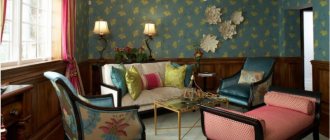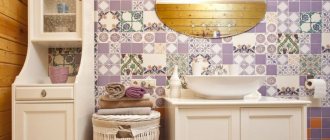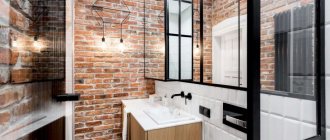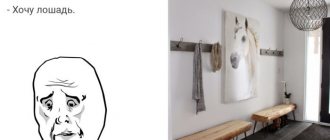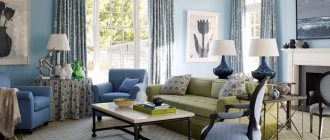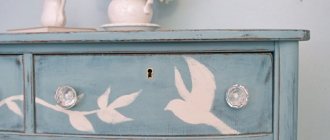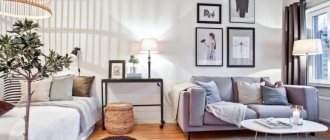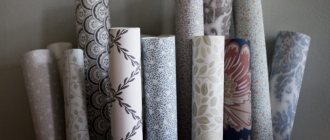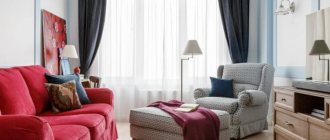An interesting finish that imitates aging.
The Provence style has a large number of fans, not only from the French, but also from residents of a large number of other European countries. Interiors designed in French country style attract with their sophistication, practicality, simplicity and elegance. This design demonstrates not only the excellent taste of the owners, but also their desire to get closer to the atmosphere typical of the houses of the French provinces of the 19th century.
In this review we will talk about possible wall design options and try to find out which of them are the most successful. We will also understand the features inherent in the style and consider some tips that may be useful when planning and implementing interior ideas.
So, Provence walls: what can they be?
Style Features
Provence is distinguished by its special delicacy of design, achieved by the use of natural materials, the lightness of the colors used, the abundance of unusual decor, and the elegance of the furniture.
It is intended for large rooms, but a small Provence style living room can also become a surprisingly cozy gathering place for all family members.
The luxury of classic design, seasoned with notes of minimalism, and the feeling of free space, comfortably flavored with cute things and flowers, are perfectly combined here.
Only in Provence will the faded shades of decoration find their place and will seem subdued by the sun's rays of the hot south and the aroma of the endless sea. And the living room itself will become a cozy island of relaxation from plastic and eternal running in circles.
Warm colors
Whether they are bright, deep or pastel, the colors of French Country interior design are soft and delicate and provide comfort. White here is always warm, it’s more likely not even white, but shades of ivory, cream or pale beige. Other colors are borrowed directly from the surrounding landscape - sunny yellow, sky blue, brick red, and also the color of peonies, sage and lavender.
Essentially, the palette of this kitchen/dining area includes three primary colors - creamy yellow, deep red and a slightly muted royal blue. Since the dominant colors are used only in small strokes, they do not disrupt the casualness of the space.
Color spectrum
The design of the Provence living room is based on the use of soft shades.
The best solution would be to use attractive shades of white (but not cold snow-white), soft sand, light cream, warm beige, elegant silver tones. And, of course, you can’t do without inserts of exquisite pink and simple lavender shades.
Additional colors will also include turquoise, olive, pistachio, mint, cornflower blue, violet, and sunny tones, but they should also give the impression of muted and time-worn colors.
Many faces of fabrics
Just like furniture, French Country fabrics create an artful, eye-catching potpourri. The quintessence of this style is the veil, but you should not neglect other materials, checkered and striped, floral and plain. Textured fabrics such as linen and matlasse, as well as famous French tapestries, add tactile interest to the room.
Ceiling decoration
The finishing of the ceiling, as well as all other floors, is made from natural materials. The ceiling slab is painted with light paint, whitewashed, plastered, and covered with light wallpaper.
For large and high rooms, the ceiling is decorated with wooden beams. To create a bright accent, they are additionally impregnated with a dark stain, which exquisitely echoes the “antique” frames and window sills. Sometimes the gaps between the beams are filled with light-colored lining.
DIY crafts: useful ideas
Homemade products can be made from various materials and in different styles. The main goal in such decoration remains to create a beautiful space and increase its functional use.
An unusual solution for napkins will add a festive atmosphere to even the most ordinary dinner or lunch.
This decor of napkins will make any lunch or dinner festive.
The most popular crafts are:
Spice boards are usually made of wood, and potholders are made of fabric. Coasters for cups are made from CDs, which are decorated with various designs. Topiaries are made from foam plastic.
Next, we will take a closer look at the manufacture of all these accessories.
Perhaps you will find useful information about creating a design for a small kitchen of 4 square meters. m. in "Khrushchevka".
Floor decoration
The most ordinary solid board is perfect for the floor; sometimes it is additionally coated with light paint.
Parquet laid staggered will add additional luxury.
Laminate would be a good option, but it should also give the impression of natural wood; specially drawn scratches, abrasions, chips, and knots will look great on it.
A combined living room in the Provence style, which continues the kitchen, can be decorated with terracotta tiles with imitation “stone” or with a floral pattern.
Wall panels
Geometric veneer panels are a fashion hit of the 21st century. Only the top layer of a two-layer panel is made from valuable wood veneer; the base is made from chipboard or MDF. Such panels are usually made to order, which means they can look completely different. They have one significant advantage: unlike parquet and solid wood, thin veneer is not afraid of humidity and temperature changes.
The most classic option for interior wooden wall decoration is Wainscot. This is the name given to decorative wall panels originally from England. They were invented for the purpose of thermal insulation of cold British houses, but then they also discovered the decorative potential of such finishing.
Often, only the lower part of the wall was covered with wood to protect it from mechanical damage that furniture could cause.
In its minimalistic interpretation without carvings or decorations, Wainscot has become an integral part of the American colonial style, so that such panels are sometimes mistakenly called American. And in France, a similar wall covering is known as bezerie. Unlike vaiscott, boiserie was often made to cover the entire wall, with openwork patterns and pastel colors.
Traditionally, such panels were made from solid oak; today, Vainscot is even made from MDF or imitated using boards and moldings. So the slatted version of the wiscott is essentially a lining with a horizontal rail.
Wallpaper 2022: trends for your walls
What materials are fashionable wallpapers disguised as, how does toile de Jouy differ from chinoiserie, is your interior ready for tigers and cranes, and is it possible to decorate the walls with dried pumpkin peel? All about wallpaper trends 2022.
Total or accent wall decoration with wood is the leading trend of the last few years and at the same time is a solution that exists outside of fashion and time. The Lanskoy TC showrooms will help you choose the right finishing material that meets the needs of your interior.
Wall decoration
The interior of the Provence living room will be perfectly combined with wallpaper in small flowers, paint or plaster. Moreover, both of the latter options may have traces of brushes, scuffs or cracks.
One wall can be decorated with wood panels or light brickwork.
The doors are selected from light wood or additionally coated with a layer of paint; it is possible to use glass or light stained glass inserts. To give simple canvases additional luxury, they are often decorated with decoupage napkins of a suitable theme.
Window frames are chosen to be light, except when dark ceiling beams are used, and the openings themselves, if possible, are made large, decorated with light curtains.
Mixing with loft
The design of the room, consisting of several different directions (Provence and loft), looks especially unique. The main rule when arranging a mixed style in the interior is to find harmony of all individual components. Here you need to choose the right color palette, not overdo it with the decor and arrange the furniture correctly.
Brickwork and cozy furniture
The main features of the loft are:
- spacious premises;
- brick walls, concrete floors, ceilings of complex structures;
- the simplest possible finishing;
- functionality;
- practicality.
IMPORTANT: the peculiarity of the loft is maximum space and fresh air.
Large room and bright details
If for Provence an important role is played by decorating window openings with light and translucent curtains, then in a loft the windows are not decorated . The use of strict roller blinds is allowed here.
The ceiling surfaces in the loft are rough, often decorated with wooden beams and complex metal structures. The same applies to other surfaces. They lack an even glossy shine and pastel colors. The best choice for a loft would be stone, metal or wood.
Aged furniture and ceilings
ATTENTION : Provence is distinguished by femininity and softness, while loft is more of a masculine style, in which there is rudeness and brutality.
When designing a room using a combination of Provence and loft styles, you need to choose the right interior cladding . A good choice would be light colors, closer to white in their spectrum. This will visually enlarge the space and make the room easier to perceive. To add a little loft to the interior, one of the walls should be decorated with brickwork. A universal board or laminate is laid on the floor.
Large windows and plenty of light
Lighting
There is never too much light, especially in the south of France. Therefore, it is necessary to provide a good lighting system. The ideal solution is large windows through which sunlight will enter. But it is clearly not enough for the dark realities of Russia.
The basis of artificial lighting will be a ceiling chandelier with the lights of stylized candles, a forged base, and a waterfall of crystal. The diffused light should reliably illuminate the entire room without leaving dark corners.
Intimate twilight will be created by cute floor lamps with fabric lampshades decorated with fringe, or wall sconces of antique shapes.
Furniture
The coziness of the antique furnishings is emphasized by objects made of light wood. But purchasing modern headsets is not recommended. Provence is more characterized by bent legs, decorated facades, a refined but not obtrusively luxurious appearance, and the presence of patina and scratches.
The best purchase would be a Provence modular living room, made up of chests of drawers, a sideboard and a coffee table, certainly round in shape.
In general, the furniture should give the impression that it was recently taken out of the dusty attic of a noble nest, washed, polished and slightly refined. Very simple items are also not suitable for decoration: each item should be chic and elegant in its own way.
Modern walls can be additionally painted with light or cream paint, painted or decorated using the decoupage technique.
Handles with porcelain inserts will add additional luxury.
Upholstered furniture usually becomes the center of the room; it is also distinguished by some wear and tear, which contrasts well with the elegance of wooden forms and the delicate floral pattern of natural fabrics.
The traditional set of chests of drawers, cabinets and pencil cases will be complemented by an open bookcase, rocking chair, wicker chairs or baskets.
Useful tips
Homemade items can become your favorite accessories, and your kitchen will be transformed by the little things. In addition, what is made with your own hands can be used as gifts for loved ones.
Cute do-it-yourself animals made from bright fabrics will fit perfectly into the interior of any kitchen.
“Make a master class and tell everyone,” design bloggers advise. If your homemade products turned out to be really successful, why not brag about them. Particularly relevant today:
In a word, elegant little things of our own production are in fashion, unique, simple and laconic, aimed at creating coziness, warmth, and a summer atmosphere in the kitchen.
Textiles and decor
Provence is considered the only style that loves an abundance of decor.
The curtains beautifully frame the window, delighting with their light folds and charming tiebacks. Delicate organza and transparent tulle can be set off by thicker curtains. Charming Austrian and Italian curtains will become an elegant design.
The floor will be decorated with a dim carpet with a light floral pattern.
Sofas and armchairs will be decorated with a checkered blanket and decorative pillows with monograms, roses, fleur-de-lis or more formal stripes and checks.
The table and cabinets will benefit from the presence of knitted or embroidered napkins.
A fireplace with tiled tiles will be a beautiful addition to the rustic decor. And on the mantelpiece, porcelain figurines, cute dolls, elegant candlesticks, and pictures with pastoral scenes will gracefully be placed.
Antique plates, completely unnecessary gravy boats and huge tureens are placed in the sideboard.
You can hang pictures on the walls, put wicker baskets with fruits and vegetables, and tall vases with flowers on the floor. Plants decorate cabinets, special stands, and window sills.
Most items can be made independently without much difficulty, and small flaws will only emphasize the beauty of the design.
Photos of a living room in the Provence style will help you better experience this light and sophisticated option for creating the most comfortable room for receiving guests and relaxing with your family.
Design with classics
Classic differs from Provence in pathos. Here, luxurious stucco molding is used on ceiling surfaces in the form of roses, molds, massive cornices made of wood or forged metal. Curtains are complemented by lambrequins, tassels, and tiebacks. Classic furniture is covered with elegant covers made of natural fabrics. Near the fireplace there is a huge mirror with a good frame. On the walls there are a large number of paintings in wooden frames with carvings or gilding.
A combination of Provence and classic styles
Distinctive features of classics and Provence are:
- Wallpaper that sets the tone for the entire interior. For classic styles, brutal wallpapers with various themes of hunting, outdoor recreation, and floral patterns are used. For a gentle French style, simple rustic motifs are used: flowers, birds, fields.
- Curtains. In the classics, window curtains are complemented by elegant lambrequins, tiebacks and other decors. Heavy and flowing fabrics are used here. For a rustic style, only natural materials (linen, cotton, chintz) are used, which are simple.
- Color solutions. In French Provence, faded and slightly sun-bleached colors are used, while the classics welcome bright and rich colors.
- Accessories. For Provence, wicker baskets, porcelain, floral patterns, forged candlesticks, and textiles with delicate prints are used. In the classics, massive chests, figurines with hunting scenes, and checkered rugs are more common.
In separate articles you can learn how to decorate a bedroom and living room in a classic style.
Massive curtains and furniture with carved legs
Photo of the Provence living room
Category: Living room
